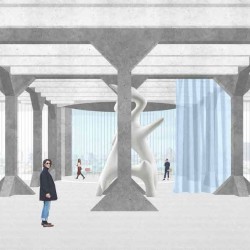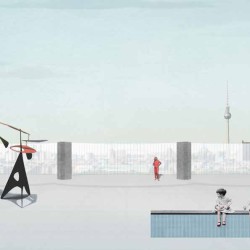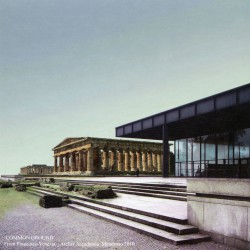Bruther . Global Arquitectura
The Site of Berlin relays on the extensive alluvial plain of Prussia, carved by a multitude of rivers, lakes, and inner seas, and surrounded by a extensive forest. A plain that man made their, by carefully installing towns, cities, roads, canals, forming a Landscape densely and intensely structured by those elements. This Site became a Place, once a chase field became a Park, streams became canals, and lakes became pounds, by the will of the emperor, the work of man, and the vision of Peter-Joseph Lenné: Tiergarten was constituted as urban space, at the doors of the city of Berlin. And this action, created a centripetal space, recreating the notion of central places determined by the island of Mitte, and the complexity of this geometric and geomorphic space.
_
Along its limits, and in contact with the Park, the most sophisticated houses where placed nearby Potsdamer Tor, the Landwehrkanal and the road to Potsdam. The war created the rupture on the urban fabric, and the post-war accentuated this emptiness through which the dense centre became a empty limit, inexplicable and void. Kulturforum is one of the Places that was formed with the meaning of reoccupying, re-centring and polarizing the fragmented city, then becoming united. Carving and Levelling where the words of inventing Berlin as Landscape, but Common Ground are probably the best words to describe what Kulturforum can mean to a complex and sophisticated city as Berlin is.
Two images, choose among many others, represents the strength and meaning of the idea of Common Ground as a main character of Kulturforum, as we see it: the one of Álvaro Siza proposal (in which he represents his vision of an intense void in tension between the expressive buildings of Hans Scharoun, the cold and rational one of Mies van der Rohe , and his one); and the one of Francesco Venezia (called ‘pianura dei Tempi’ where he represents the podium of Neue Nationalgalerie containing also classic temples, slightly elevated from a common ground made of grass and stones). Both images talks about the intensity of a void, in which diverse complex and meaningful buildings are placed in particular relation within themselves, but articulated in a clear topology of a common ground. The actual fragmentation of this common ground, due by the silent and continuous addition of urban codes made of roads, paths, garden elements, edges and trees, publicity, information, as well as maybe too diversified materials (granite, asphalt, concrete, grass, sand, in the form of cubs, parallels, aggregates, slabs), is what makes the Place of Kulturforum less special, less different, and surely less a common ground, where the most meaningful cultural institutions are nested, creating one of the multiple poles of the inspiring city of Berlin.
We want to rebuild the idea of a common ground as the basis of a Forum, in which a new almost immaterial volume of translucent matter (representing new spaces for Culture) is added, and the predominant matter of granite surface forms a new topography, where the access to the enigmatic standing columns, is allowed. Gently contrasting with the general horizontality of the Place, and the slight elevation of Gallery, a vast depression is formed, as an open yard that precedes the covered square of the entrance, and a placid pound relates our vision of St.-Matthäus-Kirche with the new translucent columns. By extending granite surfaces to roads and paths, green prairies to larger surfaces, only small and large existing and new trees recreates relations of visibility, or scale, by filtering, framing or orienting visions between Culture buildings. Departing from Valentine visions of a new Kulturforum landscape, and attaining to the material and spatial patterns of the City, we propose this opportunity to clarify, intensify and unify this unique Place at ‘der himmel uber Berlin’.
_
Bruther and Global Arquitectura collaboration on the Berlin MUSEUM FOR THE 20th CENTURY competition.
















